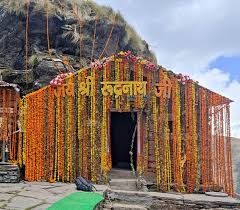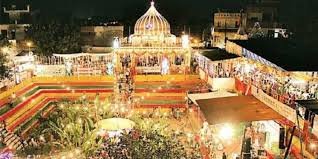Nestled deep in the Garhwal Himalayas, Rudranath Temple is one of the most mystical and revered Shiva temples in India. Located in Chamoli district, Uttarakhand, this ancient temple is part of the Panch Kedar pilgrimage and holds immense spiritual and mythological significance.
What makes Rudranath truly unique is its serene location, surrounded by dense forests, alpine meadows, and snow-capped peaks. Unlike other Panch Kedar temples, reaching Rudranath requires an adventurous trek, making it a spiritually fulfilling and physically rewarding journey.
In this blog, we will explore Rudranath Temple’s history, legends, architecture, trekking details, and travel tips to help you plan an unforgettable pilgrimage.
The Mythological Significance of Rudranath Temple
Rudranath Temple is closely linked to Hindu mythology, particularly the Mahabharata. According to legend:
- After the Kurukshetra war, the Pandavas sought Lord Shiva’s forgiveness for the sins of killing their own kin.
- Shiva, unwilling to forgive them easily, transformed into a bull and tried to avoid them.
- When the Pandavas finally recognized him, Shiva dispersed his body into five different locations. These became the five Panch Kedar temples:
- Kedarnath – The hump appeared here.
- Tungnath – The arms surfaced here.
- Rudranath – The face emerged here.
- Kalpeshwar – The hair manifested here.
Thus, Rudranath Temple is where Shiva’s face is worshiped, making it a site of immense religious significance. Devotees believe that praying here brings inner peace, enlightenment, and liberation from past sins.
Historical and Religious Importance
A Temple Rooted in Ancient Traditions
Rudranath Temple has been a spiritual center for centuries, attracting sages, devotees, and seekers who come to experience Shiva’s divine presence. The temple is believed to have been discovered by the Pandavas, and later maintained by Hindu priests following Shaivite traditions.
Even today, local priests from nearby villages conduct the daily rituals and prayers, keeping the centuries-old traditions alive.
Part of the Panch Kedar Pilgrimage
Rudranath is one of the five Panch Kedar temples, which are among the holiest Shiva shrines in India. Completing the Panch Kedar pilgrimage is considered a path to moksha (liberation), and thousands of devotees embark on this sacred journey every year.
The Mystical Architecture of Rudranath Temple
A Temple Merged with Nature
Unlike other temples with grand architecture, Rudranath blends seamlessly with its natural surroundings.
- Stone-built structure: The temple is made from locally sourced stone, giving it an ancient and timeless look.
- Shiva Lingam: The main deity is a natural Shiva lingam, worshiped as Shiva’s face.
- Small shrines: Surrounding the main temple are several smaller shrines dedicated to deities like Lord Vishnu, Parvati, and Ganesha.
The entire setting feels divine, with mist-covered peaks, lush forests, and the sound of holy chants enhancing the spiritual ambiance.
The Challenging Yet Rewarding Trek to Rudranath
A Journey Through the Himalayas
Unlike other temples accessible by road, Rudranath can only be reached by trekking, adding to its mystical aura. The trek is challenging yet rewarding, taking you through picturesque villages, dense forests, and high-altitude meadows.
Trek Routes to Rudranath Temple
There are multiple trekking routes to reach Rudranath Temple:
- Sagar Village to Rudranath (21 km) – The most popular and scenic route.
- Mandal Village to Rudranath (13 km) – A relatively shorter but steep trek.
- Urgam Village to Rudranath (18 km) – A less-traveled path with serene landscapes.
Trek Details
- Starting Point: Sagar Village (Near Gopeshwar).
- Distance: 21 km (one way).
- Trek Duration: 7-9 hours.
- Elevation Gain: From 2,000 m to 3,600 m.
- Best Time to Visit:
- Summer (May-June): Pleasant weather and lush greenery.
- Autumn (September-October): Clear skies and stunning Himalayan views.
- Monsoon (July-August): Risky due to landslides and slippery trails.
- Winter (November-April): The temple remains closed due to heavy snowfall.
Trek Highlights
- Panoramic Views: Witness the Chaukhamba, Nanda Devi, and Trishul peaks.
- Meadows & Forests: Walk through Bugyals (high-altitude meadows) and dense rhododendron forests.
- Serene Atmosphere: The trek is less crowded, allowing for deep meditation and self-reflection.
The trek to Rudranath is a perfect combination of adventure, spirituality, and nature’s beauty.
Sacred Rituals and Festivals at Rudranath Temple
Daily Worship and Rituals
- Morning Aarti: The temple priests perform Vedic rituals and Shiva bhajans every morning.
- Abhishekam (Holy Bath): Devotees offer milk, water, and bilva leaves to the Shiva lingam.
Important Festivals
- Maha Shivratri (February-March): A grand celebration with night-long prayers and fasting.
- Rudranath Mela (August-September): A special local fair attended by thousands of devotees.
- Temple Closing Ceremony (October-November): The idol is moved to Gopeshwar Temple for the winter season.
These festivals enhance the spiritual energy of Rudranath, making it a vibrant pilgrimage site.
How to Reach Rudranath Temple
- The nearest airport is Jolly Grant Airport, Dehradun (258 km).
- The nearest railway station is Rishikesh (241 km).
- Drive to Sagar Village, the starting point for the trek.
- The nearest town is Gopeshwar (5 km from Sagar Village), connected to major cities like Haridwar, Rishikesh, and Dehradun.
Why Visit Rudranath Temple?
Rudranath Temple is a spiritual sanctuary where faith meets adventure. Whether you are a devotee, trekker, or nature lover, this temple offers:
A divine connection with Lord Shiva in an untouched Himalayan setting.
A thrilling yet rewarding trek through breathtaking landscapes.
A chance to experience centuries-old traditions and rituals.
A peaceful retreat away from crowded tourist spots.
Final Thoughts
Visiting Rudranath Temple in Chamoli is an experience that awakens the soul, tests endurance, and brings one closer to nature and spirituality. Unlike easily accessible shrines, Rudranath demands devotion, patience, and perseverance, making it one of the most rewarding pilgrimages in India.
So, if you seek a divine escape into the heart of the Himalayas, plan your journey to Rudranath Temple today! 🙏✨





